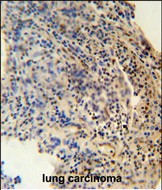ZNF197 Antibody (N-term)
Affinity Purified Rabbit Polyclonal Antibody (Pab)
- SPECIFICATION
- CITATIONS
- PROTOCOLS
- BACKGROUND

Application
| IHC-P, WB, E |
|---|---|
| Primary Accession | O14709 |
| Other Accession | NP_008922.1 |
| Reactivity | Human |
| Host | Rabbit |
| Clonality | Polyclonal |
| Isotype | Rabbit IgG |
| Calculated MW | 118847 Da |
| Antigen Region | 314-343 aa |
| Gene ID | 10168 |
|---|---|
| Other Names | Zinc finger protein 197, Zinc finger protein with KRAB and SCAN domains 9, ZnF20, pVHL-associated KRAB domain-containing protein, ZNF197, ZKSCAN9, ZNF166 |
| Target/Specificity | This ZNF197 antibody is generated from rabbits immunized with a KLH conjugated synthetic peptide between 314-343 amino acids from the N-terminal region of human ZNF197. |
| Dilution | IHC-P~~1:50~100 WB~~1:1000 E~~Use at an assay dependent concentration. |
| Format | Purified polyclonal antibody supplied in PBS with 0.09% (W/V) sodium azide. This antibody is purified through a protein A column, followed by peptide affinity purification. |
| Storage | Maintain refrigerated at 2-8°C for up to 2 weeks. For long term storage store at -20°C in small aliquots to prevent freeze-thaw cycles. |
| Precautions | ZNF197 Antibody (N-term) is for research use only and not for use in diagnostic or therapeutic procedures. |
| Name | ZNF197 |
|---|---|
| Synonyms | ZKSCAN9, ZNF166 |
| Function | May be involved in transcriptional regulation. |
| Cellular Location | Nucleus. |

Thousands of laboratories across the world have published research that depended on the performance of antibodies from Abcepta to advance their research. Check out links to articles that cite our products in major peer-reviewed journals, organized by research category.
info@abcepta.com, and receive a free "I Love Antibodies" mug.
Provided below are standard protocols that you may find useful for product applications.
Background
ZNF197 product belongs to the zinc finger protein superfamily, members of which are regulatory proteins characterized by nucleic acid-binding zinc finger domains. The encoded protein contains 20 tandemly arrayed C2H2-type zinc fingers, a Kruppel-associated box (KRAB) domain, and a SCAN box. This transcript turns over rapidly and contains 3' UTR AUUUA motifs, which are often a hallmark of rapid turnover. It is overexpressed in some thyroid papillary carcinomas. ZNF197 is located in a cluster of zinc finger genes at 3p21. Two alternatively spliced transcripts encoding different isoforms have been described.
References
Li, Z., et al. EMBO J. 22(8):1857-1867(2003)
Gonsky, R., et al. Nucleic Acids Res. 25(19):3823-3831(1997)
Calabro, V., et al. Hum. Genet. 95(1):18-21(1995)
Pengue, G., et al. Hum. Mol. Genet. 2(6):791-796(1993)
If you have used an Abcepta product and would like to share how it has performed, please click on the "Submit Review" button and provide the requested information. Our staff will examine and post your review and contact you if needed.
If you have any additional inquiries please email technical services at tech@abcepta.com.













 Foundational characteristics of cancer include proliferation, angiogenesis, migration, evasion of apoptosis, and cellular immortality. Find key markers for these cellular processes and antibodies to detect them.
Foundational characteristics of cancer include proliferation, angiogenesis, migration, evasion of apoptosis, and cellular immortality. Find key markers for these cellular processes and antibodies to detect them. The SUMOplot™ Analysis Program predicts and scores sumoylation sites in your protein. SUMOylation is a post-translational modification involved in various cellular processes, such as nuclear-cytosolic transport, transcriptional regulation, apoptosis, protein stability, response to stress, and progression through the cell cycle.
The SUMOplot™ Analysis Program predicts and scores sumoylation sites in your protein. SUMOylation is a post-translational modification involved in various cellular processes, such as nuclear-cytosolic transport, transcriptional regulation, apoptosis, protein stability, response to stress, and progression through the cell cycle. The Autophagy Receptor Motif Plotter predicts and scores autophagy receptor binding sites in your protein. Identifying proteins connected to this pathway is critical to understanding the role of autophagy in physiological as well as pathological processes such as development, differentiation, neurodegenerative diseases, stress, infection, and cancer.
The Autophagy Receptor Motif Plotter predicts and scores autophagy receptor binding sites in your protein. Identifying proteins connected to this pathway is critical to understanding the role of autophagy in physiological as well as pathological processes such as development, differentiation, neurodegenerative diseases, stress, infection, and cancer.



